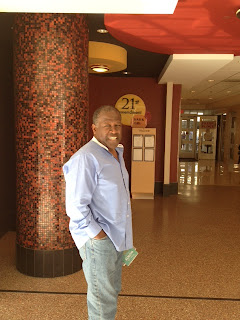Grant Green’s Idle Moments: The Suspension of Time
1963! A year synonymous with the March on Washington, the
passing of the great intellectual and social activist W. E.B. DuBois and the
horrific assassination of John F. Kennedy on the 22nd of November. I
was barely 9 months old. In the first 2 weeks of November 1963 guitarist Grant
Green lead a group of 5 musicians on a recording session at the Rudy Van Gelder
studios that became a “timeless” album named for pianist, composer Duke
Pearson’s composition “Idle Moments.”
Most events can be plotted on a timeline such as those
mentioned above. But where on a timeline would one plot an idle moment? It’s
not likely that you will find an idle moment for Albert Einstein or
any of the world’s prophets on a timeline. Pearson surmised that an idle moment
involves contemplation of some kind and although it is uncommon to think of an
idle moment as a measure of time that is exactly what it is. When it comes to
music time is the essential element that embodies the dialog between musicians
and their connection to the audience.
The truism, timing is everything, is an understatement in
reference to Grant Green’s Idle Moments.
While the music on this album does possess a contemplative quality I’ve always
felt that it represents the quintessence of the jazz idiom simply because it is
a coherent collection of rhythmically integrated tunes that “swing.” When music
swings it “floats” on the beat giving the sensation that time has been
suspended.
At the time of this writing Grant Green would have been 77
if a heart attack had not ended his life in 1979. Green, a native of St. Louis
Mo., began playing professionally as a young teenager in the late 1940s gigging
in and around his hometown and in East St. Louis, IL. His musical exposure
would have been in addition to jazz, boogie woogie, the pre-courser to rock ‘n’
roll and r&b and of course the blues. Green’s skill on the guitar enabled
him to record with tenor saxophonist Jimmy Forest and tour with soulful tenor
saxophonist Lou Donaldson in the 1950s. Apparently, Donaldson had “discovered”
Green playing in a bar in St. Louis. Donaldson was influential in Green’s move
to New York in 1960. It was a move that, with Donaldson’s help, put him in
touch with Alfred Lion of Blue Note records and proved to be, for the majority
of the remainder of his professional career, a productive relationship both as
a bandleader and as a sideman for other Blue Note artists.
Green occupies a distinctive place in the category of jazz
guitarists such as Charlie Christian, Les Paul, Django Reinhardt, Freddie Green
(no relation), Wes Montgomery, Jimmy Raney, Johnny Smith, Billy Bauer, Jim
Hall, Tal Farlow, Herb Ellis, Gabor Szabo, and Barney Kessel to name a few.
Like Charlie Christian, Green was interested more in instrumentalists from
outside the amplified strings he played. Green had an ear and preference for
horn players particularly alto saxophonist Charlie “Bird” Parker and trumpeter
Miles Davis. Green incorporated their phrasing of notes in his voicing and
technical proficiency on the guitar. Unlike Wes Montgomery, for instance, Green
did not make use of block chords, a harmonic technique effectively used by
pianists such as the late Erroll Garner. It can be said that Green played the
horn on his guitar emphasizing the meaning of certain notes and “space,”
undoubtedly a stylistic approach reminiscent of Miles while scaling notes in a
manner similar to Bird. This horn on the guitar thing represents the
intellectual layer of Green’s playing. However, being a southerner, Green also
played with a bluesy twang often heard when he wanted to emphasize the feeling
of a note. That was his signature.
Despite his success as a bandleader and sideman and recognition
as a unique jazz instrumentalist and admiration among fellow musicians Green’s
work has largely been underrated. Critical acclaim alluded him. Since the
advent of the CD he has posthumously gained a larger audience and a
retrospective notoriety with the release of previously unreleased albums.
Notably, the first recording he did at Blue Note that Alfred Lion allowed him
to do as a bandleader, First Session,
was not released until 2002, 33 years after his death. Subsequently, in 1961 he
did record four albums on the Blue Note label as a leader Gooden’s Corner, Oleo, Nigeria and Born to be Blue. The first two were released on the Japanese Blue
Note but not until 1979 and 1980 respectively. Nigeria’s release was state side in 1980. Born to be Blue was released contemporaneously in 1962, but
reissued in 1989.
Grant Green recorded more albums as a bandleader and sideman
on the Blue Note label between 1961 and 1965 than any other Blue Note artist at
that time. Idle Moments is roughly in
the middle of that productive period. Duke Pearson, the multi-instrumentalist,
composer, arranger and pianist who wrote title tune and arranged all of the
music for the album was just a few years older than Green. He died in 1980
about a year after Green. “Idle Moments” sets the mood for the whole album and
if you’re listening to the album for the first time and come to the end of the
first tune you will want to stay in the mode of suspended animation it’s
created. In that regard you won’t be disappointed. And once you become familiar
with the album, which isn’t hard to do, you’ll know what to expect.
“Idle Moments” begins slowly in a deceptively sleepy mode.
You first hear Bob Cranshaw’s bass then Pearson comes in with the first part of
the melody for two bars before Green joins in followed by Bobby Hutcherson’s
vibes. A climax builds as they harmonize the melody for a few more bars. Before
you know it you’re floating, but completely attentive; then Green breaks into
an extended solo setting the course for Person, Joe Henderson’ tenor and
Hutcherson to make their statements. A feature of this arrangement is having
Henderson lay out until his turn to solo. Until that point you’ve forgotten that
there is a tenor player somewhere in the band and when he does finally take his
part he gives the impression of “gliding” in. His sound is silky yet also
exhibits rich harmonic quality comparably similar to the acoustic bass. Only at
the end of the tune does Henderson play the melody alternating between straight
playing and adlibbing to wonderful effect..
While there are 6 tunes on the album two alternate takes.
One of Green’s composition “Jean de
Fleur” and the Modern Jazz Quartet’s tribute to jazz guitarist Django
Reinhardt, “Django.” These alternate versions are welcome variations on tunes
that already ignite immediate listener interest. They are both played at
slightly slower tempos than the originally released versions. At 13:14 minutes
the alternate of “Django” is not quite as long as the title tune, but only
slightly longer than the last tune “Nomad,” another Pearson composition. Listner
fatigue sometimes creeps in with some music and it is intuitive to think it
would easily occur on the lengthy tunes on this album. For the many years that
I’ve listened to this album I have never experienced listener fatigue. As a
matter of fact it is one of those albums that I prefer to hear straight
through. If I only hear one tune from this album I feel as though something is
missing if I don’t hear it in its entirety. Yes it’s that good! The caveat is
to listen to this album on a really good stereo or at least a set of earphones
in order to experience the full harmonic pleasure. Each musician gives
commanding and memorable performances that will have some part of your body
wiggling to or tapping out the melody or the beat.
Listen to Idle Moments and experience the sensation of the
suspension of time.
You can also hear another example of Grant Green’s work on
Lee Morgan’s Search For the New Land,
reviewed earlier on EAR-UP!
Hear Grant Green’s album Idle
Moments, 1963.
Grant Green, guitar; Joe Henderson, tenor sax; Bobby
Hutcheson, vibes; Duke Pearson, piano; Bob Cranshaw, bass; Al Harewood, drums.
Idle Moments
Jean de Fleur
Jean de Fleur (Alternate Version)
Django
Django (Alternate Version)
Nomad


















